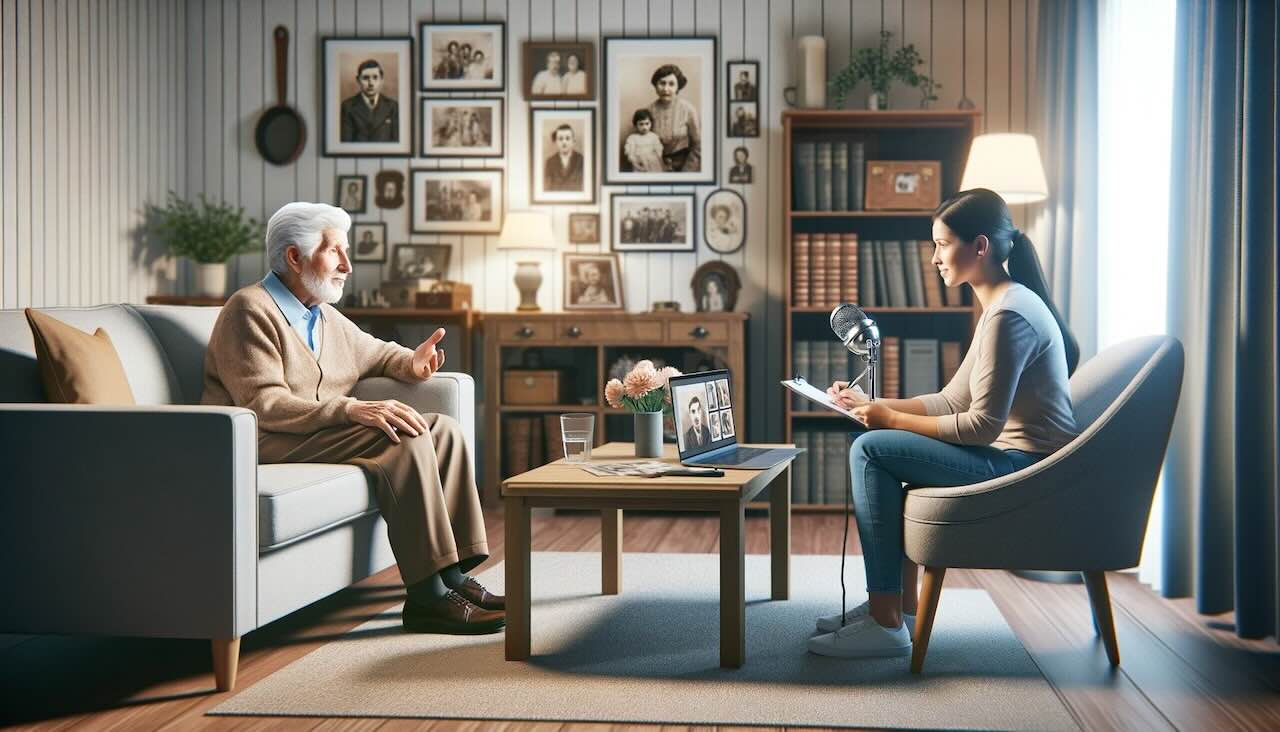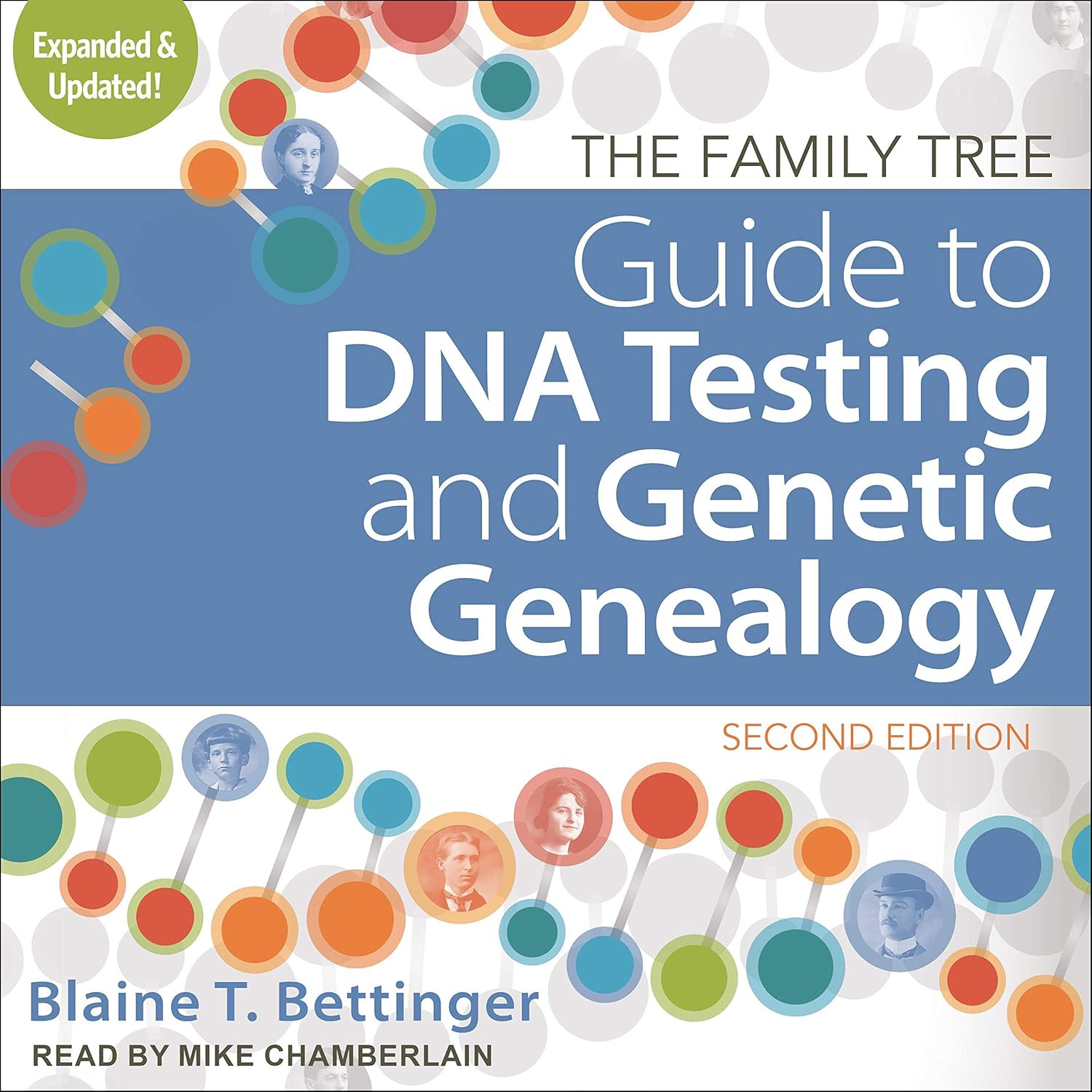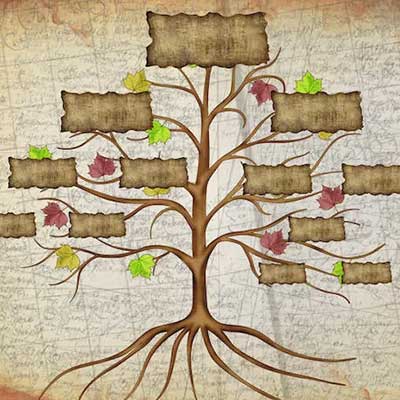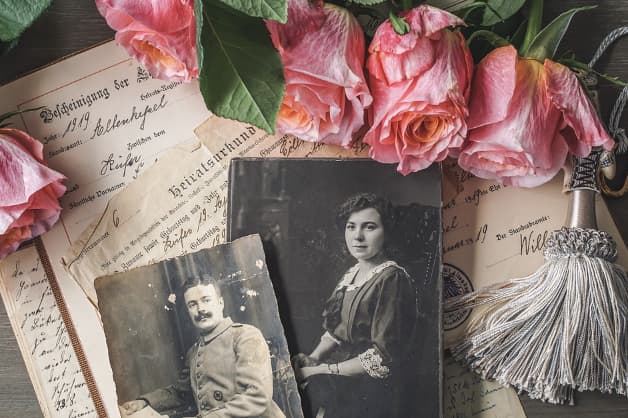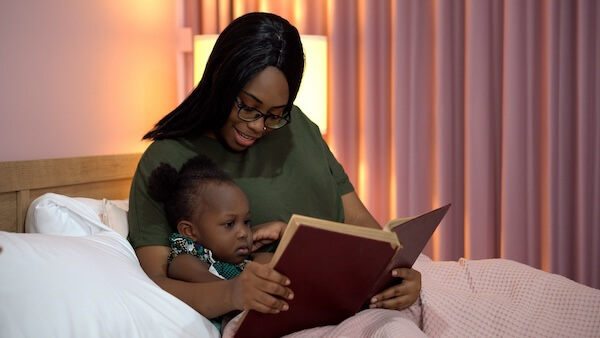- Home
- Oral History Interviews
- Stories From Grandparents
Record Stories from Grandparents
Discover how to record stories from grandparents, preserve invaluable family history, and strengthen bonds across generations. This guide offers practical tips for capturing their legacy.
The Importance of Record Stories From Grandparents
Grandparents are the living bridges to our past, carrying stories and wisdom that shape our family's legacy. Recording their stories isn't just about preserving the past; it's a way to strengthen family bonds and offer educational insights to younger generations. It's a gesture of love and respect, acknowledging their experiences and role in our family history.
Getting Started: Preparing for Your Interviews
Before diving into the recording process, it's essential to prepare. It is choosing the right equipment, whether a simple audio recorder, a smartphone, or a video camera. Creating a comfortable setting is equally important, as it helps your grandparents feel at ease and more open to sharing. Planning your questions can guide the conversation, but be ready to follow the natural flow of storytelling to record stories from grandparents.
Techniques for Effective Storytelling
Encouraging your grandparents to provide detailed descriptions and using prompts to evoke memories can lead to more prosperous, more engaging stories. The art of listening is critical; it shows respect for their experiences and encourages them to share more.
Overcoming Challenges
Recording stories can sometimes bring up emotional topics. It's essential to navigate these moments with sensitivity and understanding. Ensuring clarity in shared stories is also vital, especially for future listeners.
Innovative Methods to Record Stories From Grandparents
There are various ways to record stories, from video recordings that capture expressions and nuances to audio recordings that focus on the voice to written narratives that detail the stories in text. Each method has unique benefits and can be chosen based on your family's needs.
Incorporating Technology
Leveraging apps and software can simplify the recording process and enhance the quality of your recordings. Digital preservation ensures the stories are saved in formats that can be easily accessed and shared with family members across the globe.
Making It a Family Project
Involving children and teenagers can turn this project into a valuable family activity, promoting intergenerational connections and understanding. It's a collaborative effort that enriches everyone involved.
The Legacy of Recorded Stories
Creating a family archive of stories ensures that your grandparents' wisdom, experiences, and voices can be shared with future generations, creating a timeless treasure that celebrates your family's history.
Record stories from grandparents offer a unique opportunity to capture the essence of your family's past and present. It's a project that preserves precious memories and fosters a deeper understanding and appreciation of our origins.
Record Stories From Grandparents FAQs
1. How do I start to record stories from my grandparents?
2. What equipment do I need to record stories?
3. How can I make my grandparents comfortable during the recording?
4. What are some good questions to ask my grandparents?
5. How can I preserve and share the recorded stories?
1. How do I start to record stories from my grandparents?
Starting to record stories from grandparents is a beautiful way to preserve your family's history and create a legacy that can be cherished for generations. Here's a step-by-step guide on how to begin this rewarding journey:
1. Express Your Interest and Intentions: Share why you want to record their stories with your grandparents. Could you explain how meaningful their experiences and memories are to you and future generations? This conversation can help set the stage for a collaborative project filled with love and respect.
2. Choose the Right Time and Place: Schedule the recordings at a time and place where your grandparents feel most comfortable and at ease. A familiar environment like their home often encourages openness and makes storytelling more natural and enjoyable.
3. Prepare Your Equipment: Please decide which format you want to use for the recordings. Smartphones, tablets, or digital recorders are great for audio recordings, while camcorders or smartphones can be used for video. Please ensure your equipment is in good working order and you have enough storage space or memory cards.
4. Plan Your Questions: Although the conversation should flow naturally, having a list of questions or topics to guide the discussion is helpful. Start with broad questions about their childhood, family traditions, or significant life events, then delve deeper based on their responses. Be flexible and let the conversation take its course.
5. Create a Comfortable Setting: Ensure the recording environment is quiet and interruptions-free. Comfortable seating, good lighting (especially for video), and a relaxed atmosphere will help your grandparents feel more at ease.
6. Test Your Equipment: Before starting, quickly test your recording equipment to ensure everything works correctly. Could you check the audio levels, battery life, and storage space?
7. Start Recording: Begin the session with a gentle prompt or an easy question to help your grandparents understand storytelling. Remind them there's no rush and encourage them to take their time with their responses.
8. Listen Actively: Show your interest through body language and verbal affirmations. Listening attentively makes your grandparents feel valued and encourages them to share more deeply and freely.
9. Respect Their Emotions: Some stories may evoke strong emotions. Be empathetic and give your grandparents the space and support they need, whether taking a break or simply being there to listen.
10. Organize and Preserve the Recordings: label and organize the recordings carefully after each session. Consider transcribing them or creating digital backups to preserve them for future generations.
11. Share and Celebrate: Share the recordings with other family members and celebrate the stories together. This can also encourage other relatives to share their stories, further enriching your family's history.
Remember, the goal is not just to record stories but to strengthen family bonds and understand your heritage more deeply. Be patient and flexible throughout the process, and cherish each moment you spend with your grandparents on this journey.
2. What equipment do I need to record stories?
Record stories from grandparents or any family member is a heartwarming way to preserve family history. The equipment you need can range from simple to more sophisticated setups, depending on your goals and the quality of the recordings you wish to achieve. Here's a breakdown of the essential equipment for recording stories:
1. Recording Device
- Smartphone or Tablet: Modern smartphones and tablets have built-in microphones and cameras that are surprisingly high in quality, making them a convenient and accessible choice for audio and video recordings.
- Digital Voice Recorder: Consider a digital voice recorder for higher quality audio recordings. These devices are designed for clear audio capture and can be more sensitive and less intrusive than larger equipment.
- Camcorder or Digital Camera: If you're focusing on video recordings, a dedicated camcorder or a digital camera with video capabilities can offer better control over video quality, zoom, and stabilization.
2. Microphones
- Lapel/Lavalier Microphone: These small microphones can be clipped onto clothing and are excellent for capturing clear speech. They work well with smartphones, tablets, and digital recorders.
- Shotgun Microphone: If you're recording video, a shotgun microphone can be mounted on top of a camera or used on a boom pole to capture directional, high-quality audio from a distance.
- USB Microphone: A USB microphone can offer studio-quality sound for interviews conducted via a computer or for a stationary setup.
3. Headphones
- Closed-Back Headphones: Using headphones during the recording allows you to monitor the audio quality in real-time, ensuring you capture a clear and audible recording without background noise or interference.
4. Tripod or Stabilizer
- Tripod: A tripod is essential for stabilizing a camera or smartphone, especially for video recordings, to prevent shaky footage.
- Smartphone Holder or Adapter: If using a smartphone for video, a holder or adapter for a tripod ensures your device is secure and the framing is steady.
5. External Storage
- Memory Cards: If you're using a digital camera, camcorder, or digital voice recorder, having extra memory cards on hand ensures you will have enough space during a session.
- External Hard Drive or Cloud Storage: transferring your recordings to an external hard drive or cloud storage solution would be best for backup and safekeeping.
6. Editing Software
- Audio Editing Software: Programs like Audacity (free) or Adobe Audition offer tools for cleaning up audio, removing background noise, and editing your recordings for clarity.
- Video Editing Software: For video recordings, software like iMovie (for Mac users), Adobe Premiere Elements, or DaVinci Resolve (free version available) can help you cut, edit, and polish your videos.
7. Lighting (for Video)
- Natural Light or Soft Box Lights: Good lighting is crucial for video. Natural light is the easiest option, but soft box lights or LED panels can help create a well-lit setting that flatters your subject if you're recording indoors.
When choosing equipment, consider your budget, the technical comfort level of yourself and your subject, and the intended use of the recordings. Even with minimal equipment, the stories you capture will hold immense value for your family's history and future generations.
3. How can I make my grandparents comfortable during the recording?
Ensuring your grandparents feel comfortable while recording their stories is crucial for a successful and enjoyable storytelling session. Here are some strategies to create a relaxed atmosphere that encourages open and heartfelt communication:
1. Explain the Purpose and Process
- Could you explain why you want to record their stories and how the recordings will be used? Understanding the value of their participation can make your grandparents feel honored and more willing to share.
2. Choose a Familiar and Comfortable Location
- Interview where your grandparents feel at ease, such as their home or a favorite family gathering spot. Familiar surroundings can help them relax and open up more quickly.
3. Use Familiar Equipment
- If you use technical equipment like microphones or cameras, introduce them to your grandparents before recording. Just let them know these tools are simply there to capture their valuable stories, and there's no need to worry about the equipment.
4. Keep the Setting Intimate
- Limit the number of people present to avoid overwhelming your grandparents. A quieter, more intimate setting can encourage more personal and detailed storytelling.
5. Plan for Comfort
- Make sure your grandparents are physically comfortable. Offer them a comfortable chair, make sure the room temperature is pleasant, and have water or their favorite beverage available.
6. Be Flexible with Timing
- Be mindful of your grandparents' energy levels and schedule the recording when they feel most alert and lively. Be willing to take breaks as needed or even split the recording session into multiple shorter sessions.
7. Prepare Questions, But Be Flexible
- Have a list of questions or topics ready, but be prepared to follow the natural flow of conversation. Sometimes, the most memorable stories come from unplanned detours.
8. Listen Actively and Empathetically
- Show genuine interest and empathy in their stories. Active listening can make your grandparents feel valued and encourage them to share more deeply.
9. Respect Their Boundaries
- If there are topics they're uncomfortable discussing, respect their wishes and move on to another question or subject.
10. Involve Them in the Process
- Let them have a say in how the recording is done. For instance, ask if they'd prefer audio or video recording or if there are specific stories they're eager to share. This sense of control can make them feel more engaged and comfortable.
11. Provide Encouragement and Gratitude
- Offer positive feedback and express appreciation for their willingness to share their stories. Knowing their experiences are valued can make your grandparents feel more comfortable and appreciated.
Creating a comfortable environment for your grandparents ensures a smoother recording process and deepens your connection with them, enriching the experience for both of you.
4. What are some good questions to ask my grandparents?
Asking your grandparents the right questions can unlock a treasure trove of family history, wisdom, and personal stories. Here are some thoughtful questions that can help you delve deeper into their lives and experiences, ensuring a rich and meaningful conversation:
Childhood and Family Background
1. What are your earliest memories of childhood?
2. Can you tell me about the house you grew up in?
3. How did you celebrate holidays and birthdays when you were young?
4. What were your parents and grandparents like?
5. Did you have any siblings, and what were your relationships with them like?
Education and Career
6. What was your experience in school like?
7. Did you have a favorite subject or teacher?
8. How did you decide on your career or profession?
9. What was your first job, and what did you learn from it?
10. Can you share a pivotal moment in your career?
Love and Relationships
11. How did you meet grandma/grandpa, and what was your courtship like?
12. What advice do you have for a happy marriage or partnership?
13. Can you tell me about the day my parent(s) was/were born?
14. What were some challenges you faced in your relationships, and how did you overcome them?
Personal Interests and Hobbies
15. Have you had any hobbies or interests that you've been passionate about throughout your life?
16. Are there any particular books, songs, or movies that have been significant to you?
17. How have your hobbies and interests changed over the years?
Life Experiences and Wisdom
18. What are some of the most important lessons you've learned in life?
19. How has the world changed most significantly during your lifetime?
20. Have you ever had a life-changing experience, and what did you learn from it?
21. What do you feel most grateful for in your life?
Reflections and Legacy
22. How would you like to be remembered?
23. Is there anything you've always wanted but have yet to do?
24. What hopes do you have for future generations of our family?
25. What advice would you give your younger self if you could?
Miscellaneous
26. Are there any family traditions you hope will continue?
27. Can you share a story about a relative I never met?
28. What was the happiest moment of your life?
29. What was the most challenging period in your life, and how did you navigate it?
30. If you could relive one day of your life, which would it be and why?
These questions can be a starting point for a rich dialogue with your grandparents. Remember to listen actively and follow up on their stories with more questions to dig deeper. The goal is to create a comfortable space for them to share, reflect, and impart their wisdom, making the conversation as enjoyable and meaningful for them as it is for you.
5. How can I preserve and share the recorded stories?
Preserving and sharing the recorded stories of your grandparents ensures that their memories and wisdom are passed down through generations. Here are effective ways to preserve these precious narratives and share them with family members:
1. Digital Preservation
- Convert to Digital Format: If your recordings are not already digital, convert any tapes or analog recordings to digital files. This prevents degradation over time.
- Use High-Quality Formats: Save audio recordings in lossless formats like FLAC or WAV for audio and MP4 or MOV for video to ensure long-term quality preservation.
- Backup Files: Create multiple backups of the recordings. Use external hard drives, USB flash drives, and cloud storage services like Google Drive, Dropbox, or iCloud to safeguard against data loss.
2. Organization and Cataloging
- Organize Thoughtfully: Create a digital library of the recordings, organizing them by date, subject, or storyteller. This makes it easier to locate specific stories in the future.
- Metadata: Add metadata to the files, including titles, dates, names of the people involved, and keywords about the story's topics. This aids in searching and categorization.
3. Transcription
- Transcribe Stories: Convert the audio or video recordings into written text. This not only makes the stories accessible to those who may prefer reading but also ensures a textual record can be easily preserved and shared.
- Use Transcription Services: If manually transcribing is too time-consuming, consider using transcription services or software, though reviewing and correcting any errors these tools might make is essential.
4. Create a Family Website or Blog
- Share Online: A family website, blog, or social media group can be an excellent platform to share these stories. With the storytellers' permission, upload audio clips, video recordings, or transcribed stories.
- Privacy: Ensure the platform is secure and consider privacy settings that allow only family members to access the content.
5. Publish a Family Book
- Compile a Book: Use the transcribed stories to create a family book. Include photographs, recipes, and other memorabilia to complement the narratives.
- Self-Publish: Many self-publishing platforms can help you print copies of your family book for distribution among family members.
6. Create Multimedia Presentations
- Use Photos and Music: Create multimedia presentations combining recorded stories, photographs, background music, and video clips. Tools like PowerPoint, Keynote, or video editing software can be used.
- Family Gatherings: Share these presentations at family reunions, holidays, or special anniversaries, making it a group experience.
7. Archiving for Future Generations
- Educational Use: Share these stories with future generations as a part of family history education. They can teach younger family members about their heritage and ancestors.
- Deposit in Local Archives: consider depositing copies of the recordings or transcripts in local historical societies or archives with permission. This ensures the preservation of your family's legacy beyond your means.
Preserving and sharing your grandparents' stories is a meaningful way to honor their lives and contributions. It connects present and future generations with their roots, providing a sense of identity and belonging. By taking steps to safeguard these narratives, you're creating a lasting legacy that celebrates your family's unique history and enduring spirit.
